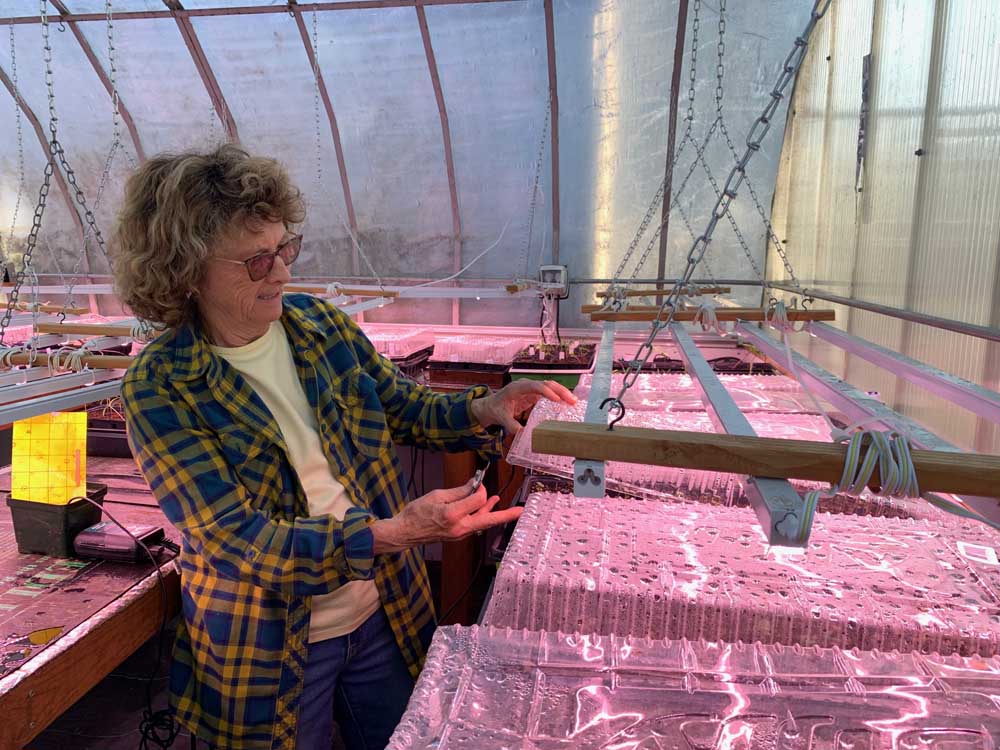GARDEN PLOTS: OSU Master Gardener shares tips for effective greenhouse growing
Published 7:00 am Wednesday, April 24, 2024

- OSU Master Gardener Virginia Brown checks seedlings growing in a propagation house on the SOREC campus. Behind her is a probe set in a container of damp soil that thermostatically controls the temperatures of the heat mats. The yellow card is a sticky trap for insects.
“There are so many different options for keeping your greenhouse functional through the hot and cold seasons — regardless of your climate. It may take some trial and error in order to figure out what works best for you and your grows, but with time and patience, there’s no doubt in my mind that you’ll find exactly what works for you.”
— Jessie Kelias, “Not Too Hot, Not Too Cold: How to Manage Your Greenhouse Gardening Temperatures,” 2023
On a recent Wednesday afternoon, I drove over to the Southern Oregon Research and Extension Center in Central Point to meet with Virginia Brown, an OSU Extension Master Gardener who has served as co-chair of the greenhouse practicum portion of the MG training class for several years. The students were just finishing a hands-on lesson about dividing perennials, and I immediately noticed that the air temperature inside the growing space was “not too hot, not too cold.”
I’m sure author Jessie Kelias would have been pleased. So was I because maintaining favorable temperatures inside the greenhouse was what I wanted to talk to Virginia about. She’s had lots of experience doing just that since the greenhouse is where many vegetable and flower starts spend time before they go on sale at the Jackson County Master Gardeners Association’s annual Spring Garden Fair.
I participated in the MG practicum in this same greenhouse back in 2011, so I felt a bit nostalgic as I sat down with Virginia for a chat.
The greenhouse is about 25-feet wide by 60-feet long and 9-feet tall and, as I mentioned in last week’s column, the frame is covered with a double-layer of polyethylene film; air can be pumped between the twin layers for added insulation. Given what Kelias wrote about the importance of sidewall vents, I was surprised to find that the MG greenhouse doesn’t have any. There’s a door on each end that can be opened and shut as needed, as well as shutter vents on both ends that open automatically when the interior air temperature reaches around 85 degrees.
The vents were closed the day I visited, but the two open doors, along with a few small fans attached near the ceiling, were circulating a refreshing breeze through the greenhouse. As cooler air was entering and moving around the enclosed space, a large exhaust fan placed in the wall at one end was efficiently pulling out warmer air that had collected inside.
Not only does their ventilation system help to keep the humidity and air temperatures at optimal levels, but Virginia said it reduces insect problems that can occur if there isn’t enough air movement among the plants. She noted that moving air also helps to strengthen the young plants’ stems, preparing them to hold their own once they’re transplanted outdoors.
The MG set-up isn’t fancy, but it’s a good example of Kelias’ advice to gear greenhouse ventilation to your specific needs. Their greenhouse isn’t used after May, so additional vents aren’t necessary; however, the system would not be as effective if it was intended for summer greenhouse growing. Also, Virginia and her students grow mostly warm-season crops, such as tomatoes and cucumbers, which fare better in warmer greenhouse temperatures.
In fact, Virginia showed me an adjacent propagation house, much smaller than the greenhouse, where seed trays with warm season crops under fluorescent lights are covered and placed on heat mats to help maintain optimal temperatures for seed germination. The seedlings are transferred to the greenhouse next door once they’ve grown their second set of true leaves (an embryonic leaf called a cotyledon is the first to appear once the shoots emerge.)
“The soil temperature has a bigger influence than air temperature, and there are certain minimum and maximum ranges required for germination of various plants,” Virginia said.
Whereas the air temperature may be only 50-55 degrees in the prop house, optimal soil temperatures are set between 65-75 degrees for growing beans, corn, cowpeas, New Zealand spinach, pumpkin, squash, cucumber and muskmelon; 70-75 degrees for sweet peppers and tomatoes; and 70-85 degrees for eggplant, hot peppers, okra, sweet potatoes and watermelon.
Most annual and perennial flower seeds germinate best when soil temperatures are between 65-75 degrees.
To keep the soil temperatures of the seed trays in the prop house consistent, Virginia and her students use a four-inch steel probe placed in a container filled with damp soil. The probe is thermostatically controlled to turn the heat mats on and off as needed.
Once the seedlings are moved to the greenhouse, they no longer need the heat mats, and a heater fan attached to the ceiling is thermostatically controlled to keep the minimum air temperature around 70 degrees. Virginia and her students record high/low air temperatures and humidity in the greenhouse on a daily basis.
She said an effective way to keep track of greenhouse temperatures is to invest in a recording thermometer that sends information via WIFI to a monitor in your home. The data can also be uploaded to an app on your smartphone. (We use a similar program to monitor and set our garden irrigation by phone).
“This allows you to react quickly to temperature changes in the greenhouse,” Virginia said.
After monitoring for optimal air and soil temperatures in the greenhouse, Virginia noted the importance of hardening off young plants before transplanting them outdoors. Two weeks before they are planted in the garden, seedlings should be brought outside during the day, kept in a shady, protected spot, and then returned to the greenhouse at night. Gradually expose the young plants to more sunlight during the day; avoid placing them outside on particularly windy days or when the air temperature is below 45 degrees.
Another tip Virginia shared is to use a soil thermometer to check if soil temperatures in the garden are warm enough before planting out seedlings. “Otherwise, their roots will go into shock and the plants won’t grow,” she said.
Spring Garden Fair
The JCMGA’s Spring Garden Fair will take place from 9 a.m. to 4 p.m. Saturday, May 4, and from 10 a.m. to 2 p.m. on Sunday, May 5, at SOREC, 569 Hanley Road in Central Point. A variety of vegetables, herbs, annual and perennial flowers and native plants will be on sale, as well as merchandise from several garden vendors.
Educational classes, children’s activities, and a food court will be available. There is a $5 parking fee; handicapped parking, as well as free carry out service, will be provided. Proceeds of the sale will help the OSU Master Gardener Program.






